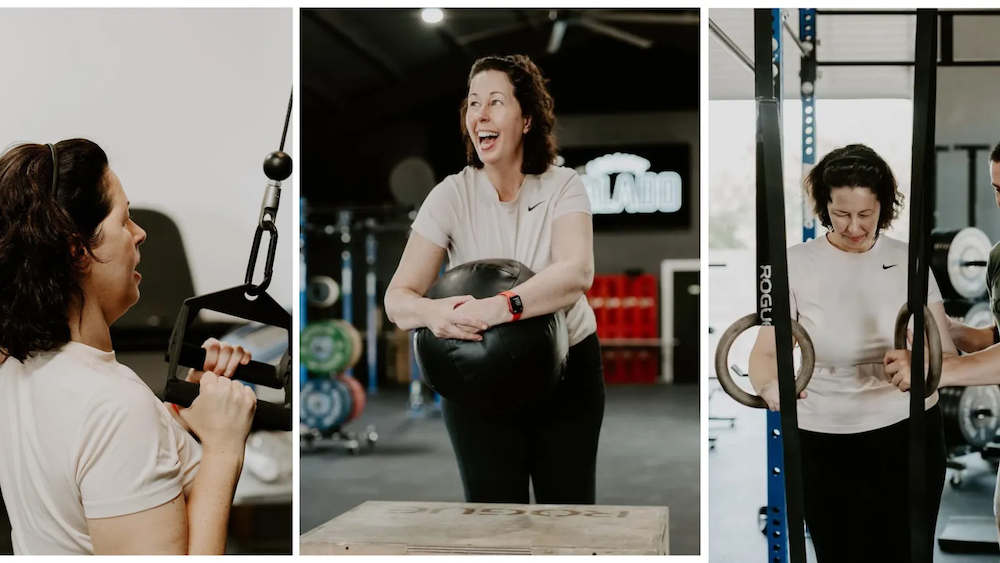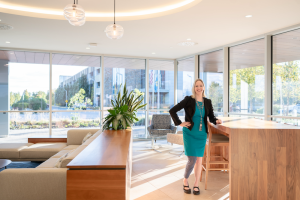
My name is Hether Flanigan. I live in Salado, TX, and I just turned 50 years old. Three years ago, I had a massive stroke, despite being otherwise healthy. I was active. I ate healthily. I didn’t have high blood pressure. I never had any major health issues. And yet, I had a stroke.
Determining the cause of the stroke
The doctors ran hundreds of tests to try to determine the cause of it. Eventually, they found that estrogen was the cause of the blot clot, but they weren’t sure how it got to my brain. They ran even more tests and found that I had a PFO, which is a hole between the left and right atria (upper chambers) of the heart. Ultimately, being on birth control and the PFO are what led to the stroke.
The blood clot was so massive that it was causing a concerning amount of swelling in my brain. I was rushed into emergency surgery at Baylor Scott & White Medical Center in Temple, TX, which fortunately is a Level 1 Stroke Center. They removed a flap in my skull to account for the swelling and I stayed for another two weeks.
Starting rehab after surgery
During this time, my husband toured rehab hospitals in the area so that I could have the best possible care. He was impressed by the doctors and patient progress at Encompass Rehab Hospital in Round Rock, TX and I was transported by ambulance there since the flap in my skull was still open.
At this point, I still didn’t realize the gravity of the situation — the magnitude of what had happened to me. I wasn’t aware of my deficits. I just wanted to get back home. I wanted to return to my life and my son, who was 15 at the time.
That wasn’t an option. I started with speech therapy, physical therapy, and occupational therapy for 50 minutes a day, five days a week. I had to relearn how to swallow and relearn how to talk. I couldn’t get out of bed by myself. I was in a wheelchair. I finally was starting to accept how severe my stroke was.
Struggling with my mental health
I soon became very depressed. Before the stroke, I was energetic and independent. After the stroke, I was so tired all the time. I couldn’t move my arm. I felt so disconnected from my body.
Thankfully, I found joy in physical therapy. I was learning how to stand up, how to transfer in and out of my wheelchair, and how to walk on the parallel bars. I realize now it’s a miracle I can even walk at all. But I think my denial about the severity of my stroke helped me in some ways. I worked so hard in those early weeks and months and was so determined to get out of the hospital and back home.
Transferring to a residential inpatient facility for young brain injury survivors
Being able to walk again was so important to me. There was no other option. I loved to walk. It was a big part of who I am. So for five weeks, I worked hard at therapy and then transferred to a residential inpatient facility for young brain injury survivors called Neuro Restorative also in Round Rock, TX.
Everyone there was under 50 and it was a very communal place, but I hated it. I wanted to be home. I made it a goal to get home by Mother’s Day, which was about three weeks from the time I arrived. Again, I received speech, occupational therapy, and physical therapy. Again, I loved the physical therapy. And for a time, I resisted OT because they weren’t focusing on my arm and I wanted so badly to be able to move it again. In speech therapy, I felt like I was challenged, which I liked.
Between my various therapies and the group activities at the center, my days were pretty full. By the end of it, I was exhausted. My husband would come every day after work and we’d eat dinner together and he’d help me with my skincare to then go home and get our kids in bed. He was amazing through the whole thing.
Finally going home
On Friday, May 8th, a few days before Mother’s Day, I was finally discharged, 8 weeks after suffering my stroke. I definitely needed more therapy but didn’t realize it at the time. I knew I still couldn’t use my arm, but I didn’t know what I would need to do to regain function.
As much as I had looked forward to going home, as soon as I got there, I got very very sad. I was no longer in a facility bubble. Once I was home, I realized I was no longer the person I was before my stroke. That’s when it all hit me and I became very depressed.
I was still in a wheelchair. I had to wear a helmet to protect my brain because my skull flap repair surgery was still a few weeks away. It was all very difficult. I cried all day every day. I truly was at my lowest.
Finally, I had the cranioplasty surgery to put the skull flap back in, and thankfully, the surgery went smoothly. From there, it was a few weeks before I was able to restart therapy. We were referred to a company called Rehab Without Walls, which specializes in neurological care. Rather than in-patient, they come to your home.
I loved my therapist. For the first time, it felt like I was getting therapy to get better, not just to adjust to my new normal as someone living with a disability. And I was so eager to get better. I had sessions two or three times a week, and when they weren’t there, they gave me a ton of exercises to do at home.
Around this time, I also started exploring more on social media, where I was able to learn the stories of other stroke survivors and learn more about brain injuries. Overall, I was doing better. I was walking more with a cane and an AFO and was in a better spot mentally.
Trying to go back to work
Soon, I started to want to go back to work. Before my stroke, I was a very career-oriented sales trainer. I loved my job and I was good at it. And realistically, my husband Randy and I needed two incomes if we were going to continue to support our lifestyle.
In my mind, I felt ready. I was 7 months post-stroke and still didn’t have use of my arm but had still made great progress in other areas of my rehab. Once I started working again, I realized I had difficulty paying attention and had a hard time keeping up. It was difficult to do everything with my right hand and I could never respond fast enough on Microsoft Teams. I felt like I was constantly falling behind.
I hated looking at myself on camera because my hair was shaved from my craniotomy and it was another reminder of how impacted I was by the stroke. I hated the way I looked and I hated the way I felt.
I realized going back to work maybe wasn’t the best for me. I was hard on myself and became sad again. A few months later, my boss called me and said it wasn’t working. I agreed with her and we decided to part ways.
Focusing more on my mental health
In retrospect, leaving my job gave me more time to work on my home exercises and more freedom in the way I spent my time. I started meditating, listening to podcasts, and connecting with other stroke survivors on Instagram. It was a period of a whole lot of introspection and I am grateful for the time to learn more about myself.
I started focusing more on my mental health and learning how to re-regulate my nervous system after sustaining a brain injury. I worked with counselors and was finally able to address the trauma of surviving a stroke. I even worked through things in my life that had happened before the stroke.
Joining a gym
My mindset was changing and it was around this time that I decided to join a gym. I joined Anytime Fitness and felt so empowered. I made myself a schedule and was so motivated to get strong.
One day, I was lifting weights and the owner came up very concerned. He said I shouldn’t be lifting weights. I felt so discriminated against. We ended up making up but I soon realized I needed more support.
From there, I ended up joining a CrossFit gym. I started going once a week to do personal training with a coach named Jeremiah. I loved it. I felt powerful not just physically but mentally too. I have continued to do that for over a year now. I feel stronger. I have better balance. My mental health is much better than it used to be.
Learning about the Cionic Neural Sleeve

Even though I was seeing improvements in my mobility, I still needed an AFO to walk most of the time. I started walking barefoot around the house and had some success, but there were many close calls where I almost fell.
Then I came across the Cionic Neural Sleeve on social media. It had just been FDA-cleared and I was so excited. A device that delivers electrical stimulation to the muscles to improve walking? I told my husband, Randy, “We are getting one.”
We placed an order and I had my initial onboarding appointment. It took some trial and error to get the settings right but I’ve seen such great improvements. I no longer have to wear my AFO, other than at CrossFit when I’m carrying heavy weights.
It’s helped my knee pain tremendously. It’s helped alleviate spasticity. I feel like my brain connects with my muscles more. I don’t have to think about how to walk as much. I have so much more peace of mind while I walk. I feel more independent. I feel much safer leaving my house. I felt so trapped before and it’s given me more freedom.
Even when I don’t have the sleeve on, I don’t have to wear my AFO. There’s so much carryover. It’s helped expedite my recovery in ways I never could’ve imagined. I’m excited to see where I’ll be in a year from now. I’m determined to continue making measurable progress.
To follow along on Hether’s journey, you can follow her on Instagram.
This is a user story from a Cionic customer, who has not been compensated to share their story. Individual results and experiences may vary. Consult with your doctor on treatment decisions.





